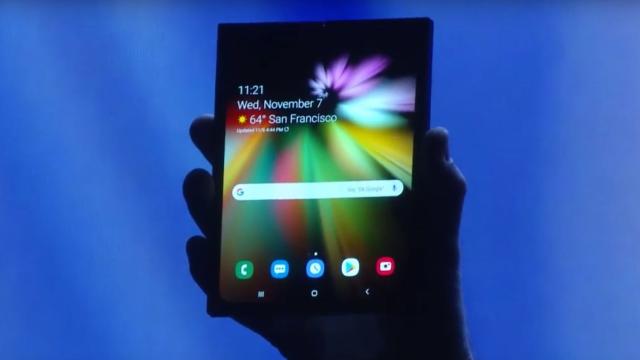People have been talking and dreaming about bendable screens for years, and while a handful of devices have experimented with the idea, there’s still a lot of hardware and software that needs to be refined before the tech is truly worth caring about. But at the 2018 Samsung Developer Conference, the world’s biggest smartphone maker gave everyone a taste of what nerds have been drooling over for so long with its new Infinity Flex Display.
While Samsung was careful not to give away too much, the company’s still unnamed, bendy-screen device not only featured a tablet-sized, 18cm flexible display on the inside for all your normal smartphone stuff, it also offered a traditional display—which Samsung is calling a “cover screen”— on the outside so you can quickly access your phone without needing to unfold it.
Make no mistake, this thing looks chunky as hell, but a large part of that is apparently due to the protective shroud Samsung used to shield the rest of the device from prying eyes. On stage, Samsung senior vice president Justin Denison said the company’s new folding device will be pocketable, though until we get a full view of that device in the flesh, it’s hard to say for sure how accurate that claim is.
Still, even with just a quick glance, Samsung’s Infinity Flex Display looked significantly more polished and consumer ready than things like the recently announced Royole FlexPai. But more importantly, Samsung’s flexible display represents a potential major shift from the glass-fronted bricks we’ve been using for the last decade to something that can literally bend and change to our needs.
However, to do this meant Samsung needed to completely rethink traditional smartphone design, including both the exterior of the phone and how to make the phone fold properly, but also its internals and where to put them in a phone that can move around in ways older devices can’t.
To solve the first issue, Samsung designed new screen materials, including a flexible OLED layer and backplane, that are then layered beneath an ultra thin polarizer, a new shock-absorbent film, and a more durable (and flexible) polymer cover window on top. And to hold everything together, Samsung says it created a new flexible adhesive that could resist cracking or coming apart even after thousands of bends. All told, Samsung claims its bendy screen is the thinnest display the company has ever made.
And to enhance the potential of its Infinity Flex Display, Samsung created a new multi-tasking interface that allows people to view up to three apps simultaneously across the device’s full 18cm screen. Also, for those times when you want to transition what you see on the phone’s smaller exterior screen to the big one inside, Samsung worked with Google to create a multiple UI features such as App Continuity (or Screen Continuity depending on who you’re talking too) that allows the phone to seamlessly transition what you see on the outside cover screen to the main display without any extra hitches or delays.
Sadly, Samsung didn’t give a date or even a timeline for when this device might available (even as just a preview), though Samsung claims mass-market production of these displays should start ramping up in the next few months.
Even optimistically, it’s still too early to say mission achieved. Flexible screens could still end up being dead end tech like curved TVs or Google Glass. But at the same time, what Samsung showed today makes the idea of flexible phones a lot more tolerable than anything we’ve seen before.
